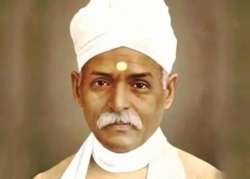Pandit Madan Mohan Malaviya: The legendary freedom fighter and educationist
New Delhi: Pandit Madan Mohan Malaviya, popularly known as Mahamana, was a devout freedom fighter, notable educationist and politician who formed Banaras Hindu University (BHU), one of the finest educational institutions in India.He left no

New Delhi: Pandit Madan Mohan Malaviya, popularly known as Mahamana, was a devout freedom fighter, notable educationist and politician who formed Banaras Hindu University (BHU), one of the finest educational institutions in India.
He left no stone unturned in India's quest for independence. His patriotism remained unbroken from youth till death.
Born on 25th December, 1861 in Allahabad to a Brahmin family, today, Malviya is a source of inspiration to many. He was among the eight children that his father, Pandit Baijnath, and mother, Meena Devi had.
He joined a Mahajani school when he was 5. After that he joined a religious school under the guidance of Haradevaji. It was here that his mind was greatly influenced by Hindu religion and Indian culture. It 1879, he completed his matriculation from Muir Central College, which is now known as Allahabad University. In 1884, he completed his BA from Calcutta University and became a teacher in Allahabad.
In 1886, he had attended the second session of the Indian National Congress (INC) in Calcutta under the chairmanship of Dadabhai Naoroji. He had also delivered an unforgettable speech in that session.
Before completing LLB from Allahabad in 1891, he had served as an editor of a weekly ‘The Hindustan' nearly for two years. In 1893, he started practicing in Allahabad High Court.
In 1907, he started a Hindi weekly 'Abhyudaya' and made it a daily in 1915.
It was in 1909 that Malviya became the president of the Indian National Congress for the first time.
It was in the 21st session of the Indian National Congress held in Varanasi that he shared his idea to build a Hindu university. It 1915, the Banaras Hindu University (BHU) Bill was passed and on 4th February, 1916 the University was established.
Today, the University is considered as an eminent institution of learning in India.
He also played a vital role in the Non-Cooperation movement started by Mohandas Karamchand Gandhi in 1920.
In 1931, Malviya Mohan represented India at the First Round Table Conference. He is also known to popularize the slogan ‘Satyameva Jayate'.
Malaviya was also the chairman of Hindustan Times from 1924 to 1946. His efforts resulted in the launch of its Hindi edition in 1936.
Malviya Nagar in Allahabad, Lucknow, Delhi, Bhopal, Durg and Jaipur are named after him. A postage stamp has been printed in India in his honour in 1961.
Malaviya National Institute of Technology (MNIT) at Jaipur is named after him, as is Madan Mohan Malaviya University of Technology in Gorakhpur, Uttar Pradesh.
On his birth anniversary in 2008, the national memorial of Mahamana Madan Mohan Malaviya was inaugurated by the then President APJ Abdul Kalam at 53, Deen Dayal Upadhyaya Marg, in the national capital.
Malaviya was married to Kundan Devi of Mirzapur in 1878 when he just 16 year old. The couple had ten children: five sons and five daughters.
The daily aarti that is performed at Har Ki Pauri, Haridwar was initiated by Madan Mohan Malaviya.
Malaviya passed away on 12th November 1946.